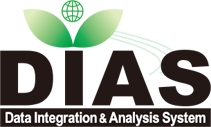


  |  |
| Name | Global Soil Wetness Project Phase 3 Atmospheric Boundary Conditions (Experiment 1) |
| Edition | Version 1 |
| Abbreviation | GSWP3.E1-ABC |
| DOI | doi:10.20783/DIAS.501 |
| Metadata Identifier | GSWP3_EXP1_Forcing20230727092724-DIAS20221121113753-en |
| Name | Hyungjun Kim |
|---|---|
| Organization | Institute of Industrial Science, The University of Tokyo |
| Address | Be607, 4-6-1 Komaba, Tokyo, Tokyo, 153-8505, Japan |
| TEL | +81-3-5452-6382 |
| FAX | +81-3-5452-6383 |
| hjkim@iis.u-tokyo.ac.jp |
| Name | DIAS Office |
|---|---|
| Organization | Japan Agency for Marine-Earth Science and Technology |
| Address | 3173-25, Showa-Cho, Kanazawa-ku, Yokohama-shi, Kanagawa, 236-0001, Japan |
| dias-office@diasjp.net |
| Name | Hyungjun Kim |
|---|---|
| Organization | Institute of Industrial Science, The University of Tokyo |
| hjkim@iis.u-tokyo.ac.jp |
| Name | Hyungjun Kim |
|---|---|
| Organization | Institute of Industrial Science, The University of Tokyo |
| hjkim@iis.u-tokyo.ac.jp |
creation : 2017-06-01
retrospective atmospheric boundary conditions (9 variables: Rainfall, Snowfall, 2m Air Temperature, 2m Specific Humidity, Surface Pressure, Downward Shortwave Radiation, Downward Longwave Radiation, 10m Wind Speed, and Cloud Cover Fraction) for 1901-2010 in 3-hourly resolution are generated. 20th Century Reanalysis (20CR) [compo2011] [Compo el al., 2011] on global 2° resolution is dynamically downscaled into T248 (~0.5°) grid using a spectral nudging technique [Yoshimura and Kanamitsu 2008] in a Global Spectral Model (GSM) [Figure 2]. This successfully keeps the low frequency signal of original reanalysis, providing additional high frequency signals, which are lacking in previous products [e.g., Weedon et al., 2011]. It is essential to investigate phenomena at higher spatiotemporal scales such as extreme events. In order to relieve known artifacts (e.g., ripple patterns and persistent overcast in high latitude region), additional techniques, such as single ensemble correction [Yoshimura and Kanamitsu, 2013] and vertically weighted damping [Hong and Chang, 2012], are applied. Model biases in the downscaled 20CR are corrected using observational data (e.g., GPCC for precipitation, SRB for short/long wave radiation, and CRU for air temperature and daily temperature range). In addition to previously introduced bias correction algorithms [e.g., Weedon et al., 2011], variability in higher temporal (<month) resolution is carefully corrected [Kim et al., in preparation]. Also, wind-induced precipitation undercatch correction is applied considering different types of gauges and their global distribution [Hirabayashi et al., 2008]. Through the above mentioned data generation strategy, GSWP3 has further reliability and consistency over the century long target timespan with higher spatiotemporal resolutions.
climatologyMeteorologyAtmosphere
| Begin Date | 1901-01-01 |
| End Date | 2010-12-31 |
| Temporal Characteristics | 3hourly |
| North bound latitude | 90 |
| West bound longitude | -180 |
| Eastbound longitude | 180 |
| South bound latitude | -90 |
| Dimension Name | Dimension Size (slice number of the dimension) | Resolution Unit |
|---|---|---|
| time | 321416 | 180 (minute) |
| row | 360 | 0.5 (deg) |
| column | 720 | 0.5 (deg) |
| Keyword Type | Keyword | Keyword thesaurus Name |
|---|---|---|
| discipline | GSWP3, Forcing Data, Surface Climate, Surface Meteorology | others |
| Keyword Type | Keyword | Keyword thesaurus Name |
|---|---|---|
| theme | DIAS > Data Integration and Analysis System | No_Dictionary |
Please contact data creator to obtain the authentication information : http://www.dias.nii.ac.jp/gswp3/input.html
| name | version | specification |
|---|---|---|
| netCDF4 | E1V1 |
Limited Access until Project Accomplishment (CC-BY 4.0 afterward; planned)
If data provider does not have data policy, DIAS Terms of Service (https://diasjp.net/en/terms/) and DIAS Privacy Policy (https://diasjp.net/en/privacy/) apply.
If there is a conflict between DIAS Terms of Service and data provider's policy, the data provider's policy shall prevail.
If you plan to use this dataset for a conference presentation, paper, journal article, or report etc., please include acknowledgments referred to following examples. If the data provider describes examples of acknowledgments, include them as well.
" In this study, [Name of Dataset] provided by [Name of Data Provider] was utilized. This dataset was also collected and provided under the Data Integration and Analysis System (DIAS), which was developed and operated by a project supported by the Ministry of Education, Culture, Sports, Science and Technology. "